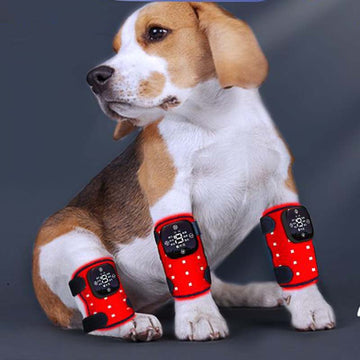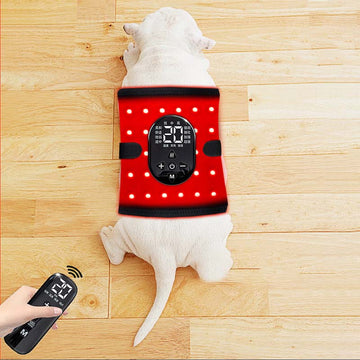Over the past decade, red light therapy—also called low-level laser therapy (LLLT) or photobiomodulation (PBM)—has grown in popularity in human wellness circles. But did you know its use is expanding rapidly in veterinary care too? For pet owners seeking safe, non-invasive ways to help their animals with pain, wound healing, skin conditions, or post-surgical recovery, red LED therapy holds promise.
But what exactly is red LED therapy for pets? How strong is the scientific backing? Is it safe? And how might you incorporate it responsibly at home in consultation with a vet?
In this guide, we’ll walk you through:
-
The mechanisms behind red and near-infrared light therapy
-
Conditions in which pets might benefit
-
What the veterinary research says—both its strengths and limitations
-
Safety considerations and contraindications
-
Practical guidelines: wavelength, dosing, frequency, and devices
-
What pet owners should look for when considering a device or treatment plan
Whether you're just beginning to explore this field or you already use light therapy devices for your pets, this post will help you build a scientifically grounded, SEO-optimized foundation.
Let’s get into it.
1. The Science Behind Red LED Therapy (Photobiomodulation)
1.1 What is Photobiomodulation?
Photobiomodulation (PBM) is a term that encompasses therapies using light (often red or near-infrared wavelengths) to stimulate cellular responses. These are non-thermal, meaning they don’t rely on heating tissues. The light is absorbed by light-sensitive molecules, especially in the mitochondria, triggering biochemical changes. PMC+2PlatinumLED Therapy Lights+2

In more detail:
-
Photons penetrate tissues and are absorbed by chromophores—especially cytochrome c oxidase (a mitochondrial enzyme).
-
This absorption can lead to photodissociation of bound nitric oxide (NO), freeing up the respiratory chain in mitochondria to function more readily.
-
As a result, ATP (cellular energy) production can increase, helping cells repair and function more optimally.
-
Other downstream effects include modulation of reactive oxygen species (ROS), activation of transcription factors, and up/down regulation of inflammatory mediators.
Because of these mechanisms, PBM is believed to help with tissue repair, reducing oxidative stress, modulating inflammation, and influencing cell signaling.
1.2 Light Wavelengths, Penetration & Dosage Principles
Not all light is equally effective. Some key principles:
-
Red light (~600–700 nm) penetrates more superficially (skin, superficial tissues).
-
Near-infrared (NIR) (~700–1000 nm) penetrates more deeply (muscles, joints).
-
Many veterinary devices use combinations (e.g. 660 nm + 850 nm) to cover both shallow and deeper layers.
-
The dose matters. In photobiomodulation, there's often a biphasic dose response: too little light has minimal effect, too much may inhibit or cause negative effects.
-
Dosage is often expressed in Joules/cm². Many studies in animals stay below ~50 J/cm². PMC+1
-
Other factors: irradiance (mW/cm²), exposure time, distance from tissue, treatment interval, duty cycle (continuous vs pulsed).
In short: wavelength, power density, and treatment timing must be calibrated carefully for effective outcomes.
2. What Conditions in Pets May Benefit from Red LED Therapy
Red LED / light therapy is not a cure-all, but veterinary and preclinical literature suggest promise in several areas. The strongest evidence exists for musculoskeletal, wound/skin, and inflammatory conditions.
2.1 Musculoskeletal & Joint Conditions (Arthritis, Osteoarthritis, Pain)
One of the most studied areas in dogs is osteoarthritis (OA). A randomized, blinded, placebo-controlled trial examined dogs with naturally occurring elbow OA, comparing PBM vs sham light therapy over 6 weeks. In that study, dogs receiving PBM showed improved lameness scores, reduced pain, and reduced reliance on NSAIDs. PMC
Another trial found that PBMT reduced pain levels and improved clinical outcomes in dogs with hip osteoarthritis. avmajournals.avma.org
However, systematic reviews note that while positive effects are reported, there is no consensus yet on the optimal protocols (dose, frequency, device type) and study quality is variable. PMC
In general, for joint pain / arthritis, PBM may:
-
Help reduce inflammation
-
Stimulate cartilage support
-
Enhance microcirculation
-
Provide analgesic effects
2.2 Wound Healing & Post-Surgery Recovery
Red/NIR light can accelerate wound closure, improve collagen synthesis, and reduce scarring. Some veterinary surgical practices incorporate light therapy in post-op recovery. PMC+1
Moreover, a recent study on atopic (allergic) dogs indicated that PBM may influence the skin microbiome, reducing pathogenic Staphylococcus abundance (though diversity overall was not significantly altered) when compared intra-individually. MDPI
Thus, applications in dermal repair, lesion management, and dermatologic conditions are under active exploration.
2.3 Skin, Inflammatory & Dermatological Conditions
Beyond wound healing, PBM is being investigated for skin inflammation, hotspots, dermatitis, and immunomodulation. Some preliminary findings suggest benefits in controlling skin microbiome imbalance, reducing inflammation, and supporting barrier repair. MDPI+1
2.4 Limitations & Conflicting Findings
It’s important to emphasize limitations:
-
The existing literature is heterogeneous (different devices, doses, wavelengths) making comparisons hard. PMC+1
-
Some studies show modest or inconsistent improvements.
-
Many studies are small-scale, open-label, or non-randomized.
-
Long-term outcomes and standardized protocols are not well established.
Thus, while red LED therapy is promising, it should be considered a complementary, not replacement, therapy under veterinary guidance.
3. Is Red LED Therapy Safe for Pets? Risks, Contraindications & Precautions
Safety is a major concern for pet owners. In general, red LED / PBM is considered low-risk, but there are crucial caveats.
3.1 Safety Profile & Known Side Effects
-
Because PBM is non-thermal (does not heat tissue significantly), it’s much safer than heat-based therapies.
-
Most studies report no serious adverse events when used appropriately. Light Therapy+2PMC+2
-
Minor risks include skin irritation, temporary erythema (redness), or discomfort if applied incorrectly or too close.
-
If the device is misused (too high power, too long), burns or overheating may occur — particularly with laser devices. 宠物医疗网
3.2 Contraindications & Cautions
Avoid or be cautious in these scenarios:
-
Tumors / Cancerous tissues — stimulating cell metabolism may risk promoting growth
-
Eyes — never shine light directly into the eyes; protective eyewear is recommended
-
Pregnancy / reproductive organs — avoid exposure to the uterus or testes
-
Open growth plates in young animals — avoid irradiating the growth zones
-
Photosensitive animals / conditions — animals with sensitivity to light
-
Seizure disorders triggered by light (rare)
-
Areas with implants or metallic hardware — confirm with vet
Always consult a veterinarian (preferably one experienced in laser/LED therapy) before beginning.
3.3 Best Practices & Monitoring
-
Start with lower doses, gradually increase if tolerated
-
Use protective goggles for both the pet and operator
-
Avoid prolonged exposure to one spot — sweep or move gently
-
Monitor skin temperature, behavior, and reactions
-
Keep a treatment log (date, duration, settings, observed effects)
-
Schedule regular check-ins with your vet to assess progress or side effects
4. Practical Guidelines for Red LED Therapy for Pets
This section aims to be a reference you (or your readers) can follow when evaluating devices or planning home treatments.
4.1 Choosing Wavelengths & Devices
-
Look for devices emitting in red (~600–700 nm) and/or near-infrared (~700–1000 nm)
-
Dual-wavelength devices (e.g. 660 nm + 850 nm) are popular to cover both superficial and deeper tissue
-
Know the power density (mW/cm²) and total power output (mW or W)
-
Decide on form factor: pad/blanket, handheld, panel, wrap, crate
-
Check for certification, quality of diode arrays, uniformity of output, and safety features (cooling, thermal sensors)
4.2 Suggested Dosing & Frequency (General Starting Points)
While no universal protocol exists, here are conservative starting guidelines (to be adapted with vet supervision):
| Target Depth / Issue | Wavelength(s) | Power Density / Irradiance | Suggested Dose* | Session Time Estimate | Frequency |
|---|---|---|---|---|---|
| Superficial skin / wound | 630–660 nm | 20–100 mW/cm² | 1–5 J/cm² | ~10–60 seconds / cm² | Daily or every other day |
| Deeper joints / muscles | 800–900 nm | 50–200 mW/cm² | 2–8 J/cm² | ~20–120 seconds per point | 3–5× per week |
| Maintenance / chronic use | mix red + NIR | lower dose | 1–3 J/cm² | shorter exposure | 2–3× per week |
* These are starting estimates; depending on device efficiency and pet size, adjust carefully.
Example: If your probe delivers 100 mW/cm², to deliver 5 J/cm²:
Time = Energy / Power = 5 J ÷ 0.1 W = 50 seconds.
4.3 Distance, Angle & Movement
-
Maintain consistent distance (often 1–3 cm) as intensity drops with distance
-
Keep the probe perpendicular to the skin surface
-
For larger areas, move slowly or sweep rather than holding static
-
In dense fur, parting or lightly trimming fur may improve penetration (consult vet)
4.4 Duration & Treatment Plan
-
Typical single sessions last between 30 seconds to several minutes per point/area
-
Treatment courses may last 4–8 weeks, with re-evaluation
-
After initial course, shift to maintenance usage if benefit is seen
-
Always pause or re-evaluate if adverse signs occur
4.5 Integration with Other Therapies
Red LED therapy is often most effective when used as part of a multimodal plan, e.g.:
-
Joint supplements (glucosamine, omega-3, etc.)
-
Physical rehabilitation or hydrotherapy
-
Weight management, nutrition, exercise
-
Medications (NSAIDs, pain relief) as prescribed
5. Evidence Look & Caution: What the Veterinary Research Actually Says
Because claims can overrun evidence, it’s crucial to ground expectations in what the literature supports:
5.1 Strengths in Evidence
-
Positive outcomes in joint pain, lameness scores, and analgesia in some randomized studies in dogs (e.g., elbow OA study) PMC
-
Reports of improved wound healing in animal models and in practice
-
Emerging data on modulation of bacterial species (e.g. Staph) in skin microbiome in atopic dogs MDPI
-
Reviews that highlight potential but call for standardization of protocols PMC
5.2 Gaps & Cautions in the Literature
-
No consensus on optimal dosing, intervals, or device specs
-
Many studies have small sample sizes, risk of bias, inconsistent controls
-
Some effects are modest and inconsistent
-
Long-term safety in all breeds/ages is not fully established
-
Translating results from controlled trials to real-world home settings may yield variable results
Thus, for pet owners, realism and a safety-first mindset are key. Expect incremental improvements rather than miracles, and always treat peer-reviewed studies as guidance, not guarantees.
6. Getting Started: How Pet Owners Can Begin Responsibly
If you're considering using red LED therapy for your dog or cat, here’s a step-by-step plan you can follow (in consultation with a veterinary professional).
6.1 Consult Your Veterinarian (Especially One with Laser/LED Experience)
-
Share your interest and ask whether they have experience with PBM
-
Discuss your pet’s medical history, any contraindications, and your goals
-
Ask whether your vet offers in-clinic sessions first (to observe response)
6.2 Start with a Low-Risk, High-Quality Device
-
Choose a device with adjustable power, safety controls, and trustworthy vendor
-
Begin with lower dose settings, short durations
-
Test on a small area first, observe for 24 hrs before proceeding
6.3 Create a Treatment Log & Monitor Response
Track:
-
Date, time, settings (wavelength, power, duration)
-
Area treated
-
Pet’s pre- and post-treatment behavior (limping, soreness, appetite, mobility)
-
Any irritation or reaction
After a full course (e.g. 4–6 weeks), evaluate whether clinical improvement is present.
6.4 Adjust or Discontinue Based on Results
-
If no benefit is noted after a full cycle, stop or re-evaluate approach
-
Scale back to maintenance usage if improvement is maintained
-
Cease use if adverse effects or worsening is observed
6.5 Manage Expectations & Combine with Holistic Care
-
Understand that red LED therapy is not a magic cure
-
Diet, exercise, weight control, supplemental therapies all remain critical
-
Use PBM to support the overall care plan, not replace conventional therapy
7. Frequently Asked Questions (with SEO Keywords)
Q1: Is red light therapy for pets safe?
A1: Yes, when used properly under veterinary guidance, red LED therapy is considered low-risk and non-invasive. Avoid use over tumors, eyes, reproductive organs, or in photosensitive pets.
Q2: What is the best red light therapy device for pets?
A2: There is no universal “best” device. Look for a quality dual-wavelength unit (e.g., 660 + 850 nm), adjustable power output, safety features, and proven vendor support.
Q3: How long before I see results?
A3: Some pet owners observe improvements in 1–2 weeks (like reduced stiffness or better mobility). But full effect often requires consistent use over 4–8 weeks.
Q4: Do I still need medications or supplements?
A4: Usually yes. Red LED therapy is best used as a complementary therapy—under a multimodal plan including nutrition, exercise, supplements, or pain medications as needed.
Q5: Can both dogs and cats benefit from red light therapy?
A5: Evidence is stronger for dogs (especially for arthritis and wound healing). For cats, fewer studies exist, but with proper dosing and guidance, cats may benefit in dermatological or healing contexts.
Conclusion
Red LED therapy (photobiomodulation) in veterinary care is a promising and increasingly accessible tool. It offers non-invasive support for pain, inflammation, wound healing, and skin health. But while early studies—especially in dogs—are encouraging, consensus protocols and long-term safety data are still under development.
If you're considering red LED therapy for your pet:
-
Consult a veterinarian knowledgeable in PBM
-
Start with a reputable, adjustable device
-
Use conservative dosing and monitor carefully
-
Treat it as part of a holistic plan (diet, exercise, vet care)
-
Adjust or discontinue based on outcomes
With a cautious and informed approach, red LED therapy can become a valuable tool in your pet’s wellness toolkit.



